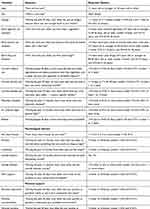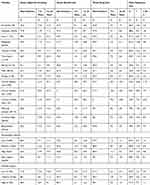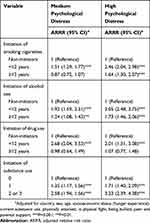Back to Journals » Psychology Research and Behavior Management » Volume 12
Early Substance Use Initiation And Psychological Distress Among Adolescents In Five ASEAN Countries: A Cross-Sectional Study
Received 18 July 2019
Accepted for publication 1 October 2019
Published 24 October 2019 Volume 2019:12 Pages 1003—1008
DOI https://doi.org/10.2147/PRBM.S223624
Checked for plagiarism Yes
Review by Single anonymous peer review
Peer reviewer comments 2
Editor who approved publication: Dr Igor Elman
Supa Pengpid,1,2 Karl Peltzer2
1ASEAN Institute for Health Development, Mahidol University, Bangkok, Thailand; 2Deputy Vice Chancellor Research and Innovation Office, North-West University, Potchefstroom, South Africa
Correspondence: Karl Peltzer
Deputy Vice Chancellor Research and Innovation Office, North-West University, Potchefstroom Campus, 11 Hoffman Street, Potchefstroom 2531, South Africa
Tel +27 18 299 4927
Email [email protected]
Aim: The study aimed to assess the associations between substance use early initiation (<12 years) (smoking cigarettes, alcohol and drug use) with psychological distress among adolescents in five ASEAN countries.
Methods: Cross-sectional data were analysed from 33,184 school adolescents, with a median age of 14 years, from Indonesia, Laos, Philippines, Thailand and Timor-Leste that took part in the “Global School-Based Student Health Survey (GSHS)” in 2015.
Results: The overall prevalence of pre-adolescent (<12 years) cigarette use was 10.6%, 8.1% pre-adolescent current alcohol use, and 4.2% pre-adolescent drug use initiation. In adjusted multinomial logistic regression analysis, pre-adolescent initiation of cigarette smoking, pre-adolescent initiation of alcohol use, pre-adolescent initiation of drug use and multi-substance pre-adolescent initiation were highly associated with medium (=1) and high (=2–5) psychological distress (of five psychological distress items: no close friends, loneliness, anxiety, suicidal ideation and suicide attempt). Late initiation of cigarette use and late initiation of drug use were not associated with medium and/or high psychological distress.
Conclusion: Early prevention programmes should target concurrent early substance use initiation in order to prevent possible subsequent psychological distress.
Keywords: early substance use, psychological distress, adolescents, ASEAN countries
Introduction
During adolescence substance use, such as alcohol, tobacco, and illicit drugs, e.g., cannabis, is often initiated and a pattern of its use may become established.1 Studies mainly in high-income countries found that early substance use initiation is associated with substance use disorders, polysubstance use, and/or mental disorders,1–4 including suicidal behaviour.5 Therefore, the study aimed at investigating the association between early substance use initiation, polysubstance use and psychological distress among adolescents in five middle-income countries in ASEAN. The prevalence of current tobacco use among adolescents in ASEAN countries was 11–15% in Brunei, Indonesia, Malaysia, Thailand, and the Philippines, and the prevalence of current alcohol use was 16% to 24% in Thailand, Vietnam, and the Philippines.6 While the prevalence of lifetime cannabis and amphetamine use was 0.9% and 1.0%, respectively, in Malaysia, and 0.6% and 0.2%, respectively, in Vietnam.7
Methods
Sample And Procedure
Cross-sectional data from the 2015 “Global School-Based Student Health Survey (GSHS)” of five ASEAN countries were analyzed. The GSHS uses a “cluster sampling design in two stages (schools and classrooms) in order to produce nationally representative samples of school children in middle schools.”8 “Students completed a self-administered questionnaire under the supervision of trained survey administrators.”8 “Country level ethics review boards approved the GSHS, and informed consent was obtained from the students, parents and/or school officials.”8
Measures
The GSHS measure questions that were used in this study are detailed in Table 1.8 “Early cigarette smoking, early drinking alcohol, and early drug use initiation were trichotomized into never, prior to 12 years, and 12 or more years.”5
The psychological distress items (no close friends, loneliness, anxiety, suicidal ideation and suicide attempt) were summed, and grouped into 0=0 low, 1=1 medium and 2–5=2 high. The four items on parental or guardian support were summed, and classified into three groups, 0–1 low, 2 medium and 3–4 high support.9
 |
Table 1 Variable Description |
Data Analysis
Descriptive statistics were applied in order to present tabulations. Multinomial logistic regression was utilized to estimate the relative risk ratios (with 95% confidence interval=CI) for medium and high psychological distress. Missing data were not included in the analysis. All statistical procedures were performed using “STATA software version 15.0 (Stata Corporation, College Station, TX, USA)”, which took into account the complex survey design.
Results
Characteristics Of The Sample
The study sample included 33,184 middle school children, with a median age of 14 years (interquartile range= 2 years) from Indonesia, Laos, Philippines, Thailand and Timor-Leste; the overall response rates ranged from 72% in Laos to 94% in Indonesia.6 The overall prevalence of pre-adolescent (<12 years) cigarette use was 10.6%, 8.1% pre-adolescent current alcohol use, and 4.2% pre-adolescent drug use initiation. There were country variations in the prevalence of pre-adolescent cigarette use, ranging from 3.3% in Laos to 11.0% in Indonesia and the Philippines, in the prevalence of pre-adolescent alcohol use, ranging from 3.9% in Indonesia to 14.1% in Timor-Leste, and in the prevalence of pre-adolescent drug use, ranging from 0.6% in Laos to 7.4% in the Philippines (see Table 2).
 |
Table 2 Descriptive Characteristics Of Substance Use Initiation |
Associations Of Substance Use Initiation With Medium And High Psychological Distress
In adjusted multinomial logistic regression analysis, pre-adolescent initiation of cigarette smoking, pre-adolescent initiation of alcohol use, pre-adolescent initiation of drug use and multi-substance pre-adolescent initiation were highly associated with medium and high psychological distress. Late initiation of cigarette use and late initiation of drug use were not associated with medium and/or high psychological distress (see Table 3).
 |
Table 3 Adjusted Prevalence Ratios For The Associations Of The Initiation Of Substance Use With Medium And High Psychological Distress |
Discussion
The study found prevalences of pre-adolescent initiation of substance use, which seem lower than in previous studies, e.g., in four Pacific Island countries (15.7% smoking; 13.8% alcohol use, and 12.9% drug use),5 France (pre-teen cigarette initiation 24.1%, pre-teen alcohol initiation 65.1% and pre-teen cannabis initiation 3.9%), and the United States (pre-teen cigarette initiation 18.1%, pre-teen alcohol initiation 27.7% and pre-teen cannabis initiation 9.7%).10 The World Health Organziation11 notes that alcohol consumption in Southeast Asia is lower than in other regions of the world, and in particular, in Indonesia, a predominantly Muslim country, alcohol use may be lower because Islam prohibits the consumption of alcoholic beverages.12
The study confirmed previous findings,1–5 showing an association between early substance use initiation and psychological distress in this adolescent population in Southeast Asia. The correlations between psychological distress, illicit and licit use of drugs, such as alcohol and tobacco, may develop, because psychological problems and illicit and licit drug users may have common risk factors.13,14
Study Limitations
The study was cross-sectional, which precludes causal inferences. Drug use was measured by self-reporting and may have been underreported. Several study indicators were assessed with single items, and future studies should employ more comprehensive measures. The study did also not assess urban–rural residence, which should be included in future studies.
Conclusion
The study confirmed previous findings, showing an association between early substance use initiation and psychological distress in this adolescent population in Southeast Asia. Early prevention programmes should target concurrent early substance use initiation in order to prevent possible subsequent psychological distress.
Acknowledgement
The World Health Organization is acknowledged for making the datasets publicly available for this analysis.
Disclosure
The authors report no conflicts of interest in this work.
References
1. Hall WD, Patton G, Stockings E, et al. Why young people’s substance use matters for global health. Lancet Psychiatry. 2016;3(3):265–279. doi:10.1016/S2215-0366(16)00013-4
2. Mathers M, Toumbourou JW, Catalano RF, Williams J, Patton GC. Consequences of youth tobacco use: a review of prospective behavioural studies. Addiction. 2006;101(7):948–958. doi:10.1111/j.1360-0443.2006.01438.x
3. Brownlie E, Beitchman JH, Chaim G, Wolfe DA, Rush B, Henderson J. Early adolescent substance use and mental health problems and service utilisation in a school-based sample. Can J Psychiatry. 2019;64(2):116–125. doi:10.1177/0706743718784935
4. Roncero C, Palma-Álvarez RF, Barrau V, et al. Early cannabis use and its relation to the development of psychiatric disorders: a review. Salud Ment. 2017;40(6):291–298. doi:10.17711/SM.0185-3325.2017.037
5. Peltzer K, Pengpid S. Early substance use initiation and suicide ideation and attempts among school-aged adolescents in four Pacific Island countries in Oceania. Int J Environ Res Public Health. 2015;12(10):12291–12303. doi:10.3390/ijerph121012291
6. Hong SA, Peltzer K. Early adolescent patterns of alcohol and tobacco use in eight Association of South-East Asian Nations (ASEAN) member states. Subst Use Misuse. 2019;54(2):288–296. doi:10.1080/10826084.2018.1517797
7. Peltzer K, Pengpid S. Cannabis and amphetamine use among adolescents in five Asian countries. Cent Asian J Glob Health. 2017;6(1):288. eCollection 2017. doi:10.5195/cajgh.2017.288
8. World Health Organization (WHO). Global school-based student health survey (GSHS). 2019. Available from: https://www.who.int/ncds/surveillance/gshs/en/.
9. Pengpid S, Peltzer K. Leisure-time sedentary behavior is associated with psychological distress and substance use among school-going adolescents in five Southeast Asian countries: a cross-sectional study. Int J Environ Res Public Health. 2019;16:2091. doi:10.3390/ijerph16122091
10. Swahn MH, Bossarte RM, Choquet M, Hassler C, Falissard B, Chau N. Early substance use initiation and suicide ideation and attempts among students in France and the United States. Int J Public Health. 2012;57:95–105. doi:10.1007/s00038-011-0255-7
11. WHO. Alcohol Control Policies in the South-East Asia Region: Selected Issues. New Delhi, India: World Health Organization, Regional Office for South-East Asia; 2006.
12. Michalak L, Trocki K. Alcohol and Islam: an overview. Contemp Drug Prob. 2006;33(4):523–562. doi:10.1177/009145090603300401
13. Degenhardt L, Stockings E, Patton G, Hall WD, Lynskey M. The increasing global health priority of substance use in young people. Lancet Psychiatry. 2016;3(3):251–264. doi:10.1016/S2215-0366(15)00508-8
14. Degenhardt L, Coffey C, Moran P, Carlin JB, Patton GC. The predictors and consequences of adolescent amphetamine use: findings from the victoria adolescent health cohort study. Addiction. 2007;102(7):1076–1084. doi:10.1111/j.1360-0443.2007.01839.x
 © 2019 The Author(s). This work is published and licensed by Dove Medical Press Limited. The full terms of this license are available at https://www.dovepress.com/terms.php and incorporate the Creative Commons Attribution - Non Commercial (unported, v3.0) License.
By accessing the work you hereby accept the Terms. Non-commercial uses of the work are permitted without any further permission from Dove Medical Press Limited, provided the work is properly attributed. For permission for commercial use of this work, please see paragraphs 4.2 and 5 of our Terms.
© 2019 The Author(s). This work is published and licensed by Dove Medical Press Limited. The full terms of this license are available at https://www.dovepress.com/terms.php and incorporate the Creative Commons Attribution - Non Commercial (unported, v3.0) License.
By accessing the work you hereby accept the Terms. Non-commercial uses of the work are permitted without any further permission from Dove Medical Press Limited, provided the work is properly attributed. For permission for commercial use of this work, please see paragraphs 4.2 and 5 of our Terms.
